Sun Fast 20
Sailboat specifications
The Sun Fast 20 is a 20’ (6.1m) cruiser-racer sailboat designed by Jacek Centkowski (Poland). She was built between 1993 and 1999 by Jeanneau (France).
Sun Fast 20's main features
- Model
- Sun Fast 20
- Hull type
- Monohull
- Category
- Coastal cruiser-racer sailboat
- Sailboat builder
- Sailboat designer
- Sailboat range
- Country
- France
- Construction
- GRP (glass reinforced polyester):
- Hull: Single skin fiberglass polyester
- Deck: Sandwich balsa fiberglass polyester - Number of hulls built
- About 500
- First built hull
- 1993
- Last built hull
- 1999
- Appendages
- Centerboard : pivoting centerboard
- Helm
- Single tiller
- Rudder
- Single transom hung rudder
- Unsinkable
- No
- Trailerable
- Yes
- Former French navigation category
- 4
- Standard public price ex. VAT (indicative only)
- N/A €
Sun Fast 20's main dimensions
- Overall length
- 21’6.4 m
- Hull length
- 20’6.1 m
- Waterline length
- 18’ 11”5.75 m
- Beam (width)
- 7’ 11”2.4 m
- Draft
- 4’ 4”1.3 m
- Draft when appendages up
- 0’ 10”0.25 m
- Mast height from DWL
- 26’ 2”8 m
- Light displacement (MLC)
- 1720 lb780 kg
- Ballast weight
- 595 lb270 kg
- Ballast type
- Cast iron
- French customs tonnage
- 2.94 Tx
Sun Fast 20's rig and sails
- Upwind sail area
- 205 ft²19 m²
- Downwind sail area
- 433 ft²40.2 m²
- Mainsail area
- 129 ft²12 m²
- Genoa area
- 75 ft²7 m²
- Symmetric spinnaker area
- 304 ft²28.2 m²
- IiFore triangle height (from mast foot to fore stay top attachment)
- 20’ 4”6.2 m
- JiFore triangle base (from mast foot to bottom of forestay)
- 7’ 10”2.37 m
- PiMainsail hoist measurement (from tack to head)
- 25’ 1”7.65 m
- EiMainsail foot measurement (from tack to clew)
- 9’ 2”2.79 m
- Rigging type
- Sloop Marconi 7/8
- Mast configuration
- Deck stepped mast
- Rotating spars
- No
- Number of levels of spreaders
- 1
- Spreaders angle
- Swept-back
- Spars construction
- Aluminum spars
- Standing rigging
- 1x19 strand wire continuous
Sun Fast 20's performances
- Upwind sail area to displacementiThe ratio sail area to displacement is obtained by dividing the sail area by the boat's displaced volume to the power two-thirds.
The ratio sail area to displacement can be used to compare the relative sail plan of different sailboats no matter what their size.
Upwind: under 18 the ratio indicates a cruise oriented sailboat with limited performances especially in light wind, while over 25 it indicates a fast sailboat. - 241 ft²/T22.42 m²/T
- Downwind sail area to displacementiThe ratio sail area to displacement is obtained by dividing the sail area by the boat's displaced volume to the power two-thirds.
The ratio sail area to displacement can be used to compare the relative sail plan of different sailboats no matter what their size. - 511 ft²/T47.44 m²/T
- Displacement-length ratio (DLR)iThe Displacement Length Ratio (DLR) is a figure that points out the boat's weight compared to its waterline length. The DLR is obtained by dividing the boat's displacement in tons by the cube of one one-hundredth of the waterline length (in feet).
The DLR can be used to compare the relative mass of different sailboats no matter what their length:
a DLR less than 180 is indicative of a really light sailboat (race boat made for planning), while a DLR greater than 300 is indicative of a heavy cruising sailboat. - 116
- Ballast ratioiThe Ballast ratio is an indicator of stability; it is obtained by dividing the boat's displacement by the mass of the ballast. Since the stability depends also of the hull shapes and the position of the center of gravity, only the boats with similar ballast arrangements and hull shapes should be compared.
The higher the ballast ratio is, the greater is the stability. - 35 %
- Critical hull speediAs a ship moves in the water, it creates standing waves that oppose its movement. This effect increases dramatically the resistance when the boat reaches a speed-length ratio (speed-length ratio is the ratio between the speed in knots and the square root of the waterline length in feet) of about 1.2 (corresponding to a Froude Number of 0.35) . This very sharp rise in resistance, between speed-length ratio of 1.2 to 1.5, is insurmountable for heavy sailboats and so becomes an apparent barrier. This leads to the concept of "hull speed".
The hull speed is obtained by multiplying the square root of the waterline length (in feet) by 1.34. - 5.82 knots
Sun Fast 20's auxiliary engine
- Engine(s)
- 1 outboard engine
- Engine(s) power (min./max.)
- 4 HP / 5 HP
- Fuel type
- Gas
Sun Fast 20's accommodations and layout
- Cockpit
- Closed aft cockpit
- Berth(s) (min./max.)
- 2 / 4
- Fridge/ice-box capacity
- 6.6 gal25 liters
- Maximum headroom
- 4’ 6”1.38 m
Sun Fast 20's saloon
- Berth length
- 6’ 7”2 m
- Berth width
- 2’ 1”0.65 m

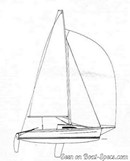

Jeanneau Sun Fast 20 sailplan - - 2/13
Picture extracted from the commercial documentation © Jeanneau
Picture extracted from the commercial documentation © Jeanneau






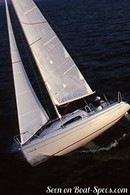
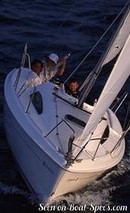

Jeanneau Sun Fast 20 sailing - - 10/13
Picture extracted from the commercial documentation © Jeanneau
Picture extracted from the commercial documentation © Jeanneau
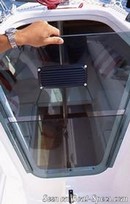

Jeanneau Sun Fast 20 interior and accommodations - - 11/13
Picture extracted from the commercial documentation © Jeanneau
Picture extracted from the commercial documentation © Jeanneau


Jeanneau Sun Fast 20 interior and accommodations - - 12/13
Picture extracted from the commercial documentation © Jeanneau
Picture extracted from the commercial documentation © Jeanneau
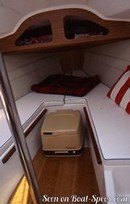

Jeanneau Sun Fast 20 interior and accommodations - - 13/13
Picture extracted from the commercial documentation © Jeanneau
Picture extracted from the commercial documentation © Jeanneau
Similar sailboats that may interest you:
Sailboats
First built hull
Hull length
1982
24’ 7”7.5 m
1996
21’6.4 m
1978
18’5.5 m
2013
20’ 6”6.25 m
1978
25’ 6”7.77 m
2015
20’ 10”6.34 m
2011
18’ 4”5.59 m
1986
21’ 7”6.57 m
2016
22’6.7 m
1994
16’ 7”5.05 m
1976
19’ 8”6 m
1999
20’ 4”6.2 m
1977
20’ 6”6.25 m
1983
22’ 6”6.85 m
2004
20’ 6”6.25 m